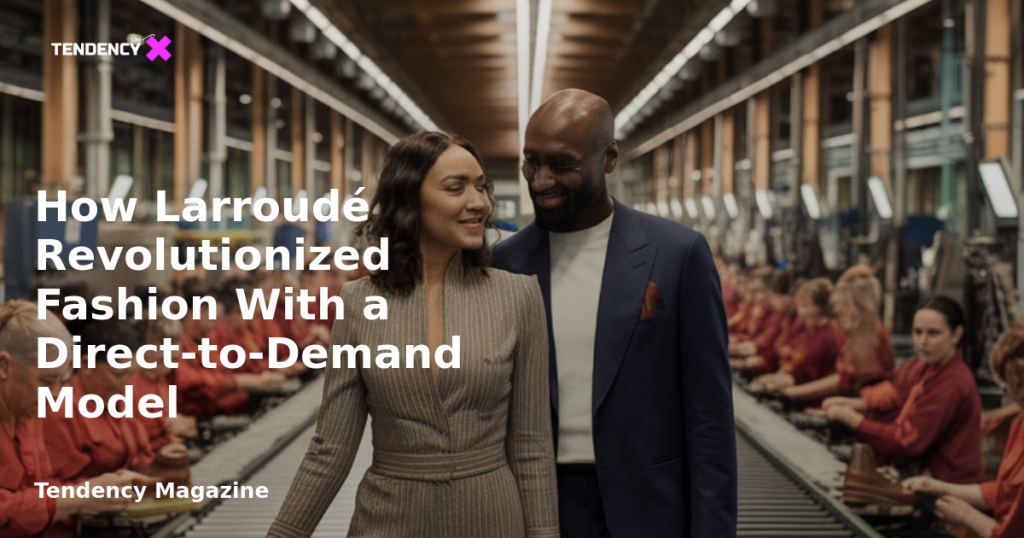How Larroudé Revolutionized Fashion With a Direct-to-Demand Model

Starting Small and Celebrating Every Milestone
Launching a fashion brand during a global pandemic might seem counterintuitive, but for Marina and Ricardo Larroudé, it was a strategic move that transformed necessity into opportunity. With a modest $4,000 investment, a Shopify website, and a clear vision, the duo established Larroudé, now recognized as one of Fast Company’s Most Innovative Companies and Footwear News’s Brand of the Year. This article explores how the Larroudés bootstrapped their way to nine-digit revenue, the advantages of vertical integration, their innovative direct-to-demand model, and the dynamics of scaling a business as a married couple.
Table of Contents
- Starting Small and Celebrating Every Milestone
- The Value of Vertical Integration
- Reframing Fashion with a Direct-to-Demand Model
- Building a Company and Marriage Side by Side
- Conclusion
When Marina and Ricardo Larroudé launched their fashion brand, they didn’t rely on substantial funding rounds. Instead, they began with what they had, testing their ideas in small, cost-effective ways. Marina recalls, “In our second month of Larroudé, we sold $5,000 and we were celebrating. And now we do that in a matter of minutes, and we are still celebrating.” Their approach was simple: start small, validate demand, and scale production only when necessary.
This bootstrap mentality has been integral to their success. Ricardo emphasizes patience and discipline: “We started doing things gradually. Trying things doesn’t cost that much money. But then when you find something that really works, then you put the money behind it.” For aspiring founders, the lesson is clear: resist the urge to overspend upfront, validate demand first, and let each milestone guide the next investment.
The Value of Vertical Integration
As Larroudé’s orders grew, the limitations of outsourced factories became apparent. Long lead times threatened to derail their momentum, prompting the Larroudés to take a bold step: building their own factory in Brazil. Ricardo discovered that the cost of a large outsourced order was comparable to purchasing used machinery outright. This move allowed them to bypass intermediaries, hire directly, and align production with demand.
Vertical integration provided several advantages: faster replenishment of bestsellers, tighter quality control, and greater flexibility to experiment with new designs. In an industry where long lead times can stifle growth, vertical integration became Larroudé’s competitive edge, enabling them to respond swiftly to market trends.
Reframing Fashion with a Direct-to-Demand Model
Traditional fashion operates like grocery stores that overstock perishable items, discounting them as they spoil. Larroudé, however, embraced a direct-to-demand model, producing only what customers order. Ricardo likens their approach to a pizzeria: “We keep the ‘dough and toppings’ ready, then make what’s ordered on demand.”
This model minimizes unsold inventory and allows the company to respond to real-time demand. Customers can preorder upcoming collections, often at a discount, providing immediate insight into popular styles. Marina explains, “If a client really likes a certain type of shoe, we go and design more shoes that are similar to that, and we are able to launch those new shoes … in a week from that day.” For shoppers, the experience feels more like participating in the creative process than buying off the rack.
Building a Company and Marriage Side by Side
Running a fast-growing brand as a married couple presents unique challenges, but Marina and Ricardo attribute their success to honesty and clear communication. “We have all the very hard conversations,” Marina says, emphasizing that nothing is left unsaid. While both are co-founders, their roles are distinct: Ricardo leads as CEO, while Marina drives the brand’s creative direction.
Ricardo highlights the importance of constant communication and mutual trust. “I think we’re best friends also,” he says, noting that clearly defined responsibilities are crucial for the company and their marriage. For employees, understanding each founder’s strengths fosters alignment across teams.
By dividing responsibilities and maintaining a united vision, the Larroudés have built a foundation capable of handling hypergrowth and the demands of leading a large team. Their experience demonstrates that co-founder partnerships, whether between spouses or not, thrive on radical honesty, trust, and role clarity.
Conclusion
From a modest dining room startup to a 550-person company with nine-digit revenue, Larroudé’s journey illustrates the power of resourcefulness, vertical integration, customer-led production, and a strong partnership. Even in challenging times, it’s possible to scale faster and smarter. By embracing innovation and staying true to their vision, the Larroudés have carved a unique niche in the crowded footwear industry. Their story serves as an inspiration for entrepreneurs seeking to navigate the complexities of building a successful brand.
2025 Tendency LTD. All rights reserved.

